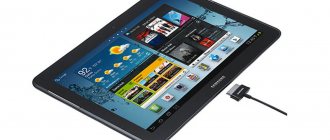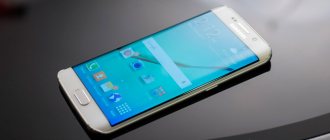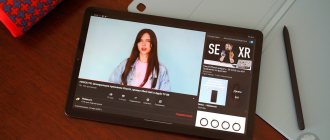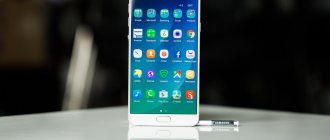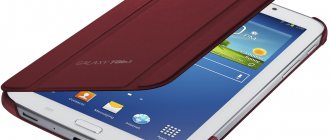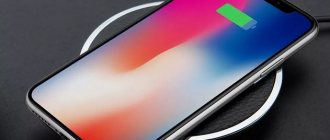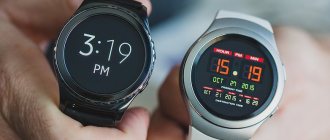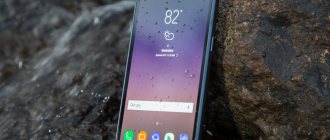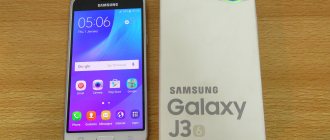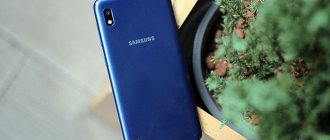The Samsung Galaxy S8 is one of the most anticipated flagships of 2017, so we decided not to delay its review. The demand for the new model turned out to be simply colossal, people lined up in huge queues and rushed to pre-order in order to be among the first to receive the first smartphone based on the Snapdragon 835 chip and with an iris scanner. The company tried to offer a truly innovative and, most importantly, reliable product in order to regain its reputation after the self-igniting Note 7. Let's review the Samsung Galaxy S8 smartphone to see how successful the flagship turned out to be this time.
Key Features
- 5.8-inch HD-Infinity display (AMOLED)
- Samsung Exynos 8895 (Europe and Asia) / Qualcomm Snapdragon 835 (USA)
- 4 GB RAM, 64 GB storage (microSD up to 256 GB)
- 3000mAh battery with wireless and fast charging
- Rear camera: 12 megapixels, f/1.7 aperture and Dual Pixel sensor
- Front camera: 8 megapixels, f/1.7 and autofocus
- IRIS and fingerprint scanner
- Samsung Bixby personal assistant
- Android 7 Nougat with Google Assistant
- Manufacturer: Samsung
- Price in Russia: 43-50 thousand rubles for Samsung Galaxy S8, and 49-55 thousand rubles for Samsung Galaxy S8+
Classic back panel design for Samsung
Camera Features
Both phones inherited the camera from their top-end ancestor, the Galaxy S7. The resolution of the main lens is 12 megapixels, and the aperture is f/1.7. The front camera is slightly worse - only 8 megapixels with an aperture value of the same f/1.7. The focal length is 26 mm, there is optical stabilization. In terms of technical strength, the camera is really no different from its predecessor. So what's new?
And the fact is that Samsung has focused on the software part of its cameras. Shooting in low light conditions has improved. The developers turned to Dual Pixel technology, which accelerated autofocus, as well as continuous shooting.
Daytime shooting (+photo examples)
When shooting during the day, there are no complaints about the camera. The pictures come out clear, highly detailed, without blur, even if the subject was in motion. The picture itself is rich, sometimes even too rich, but these are the features of all Samsung mobile equipment. The white balance is adjusted perfectly, the color gamut pleases with its maximum plausibility.
The phone copes with daytime photography with a bang - all parameters show good results. Brightness and saturation do not let you down, and the color rendition is very close to natural. The phone adjusts the white balance very sensitively, with almost no mistakes. You can, of course, accuse the camera of a slight “overcoloring”, but it’s not looks critical, but only adds richness Detailing of even slightly shaking or moving objects is also good There are no complaints about macro photography In addition to other modes, the Samsung Galaxy S8/S8+ has the ability to manually adjust focus You can independently choose which plane your phone should focus on
By the way, you can shoot in two modes - auto and manual. Manual mode allows you to adjust exposure, shutter speed, ISO, and white balance. In addition, the S8/S8+ offers several preset modes to choose from. However, even without them the camera behaves quite decently.
Shooting in low light (photo)
We are already accustomed to the fact that in poor lighting conditions, when it begins to get dark outside or you enter a room with your camera, the quality of shooting sharply deteriorates, the picture acquires a lot of noise, blurriness appears and saturation disappears. This does not happen in the case of the Galaxy S8/S8+. The phone takes excellent pictures even in dim light.
The picture was taken during the onset of evening - there is no noise, and the detail is as high as during daytime shooting. Saturation has not disappeared anywhere, the colors are bright and pleasant. The picture is no worse indoors - The colors are rich, there are no blurs, the brightness also copes with dim light. How do you You can see for yourself that the camera on the new Samsung Galaxy S8/S8+ is not inferior, but also superior to some DSLRs
Front-camera
8 megapixels allow the front camera to take pictures with quality no worse than the main lens. It supports autofocus mode and auto face retouching. The camera does not have its own flash, but the screen backlight is a good substitute.
Even in dim light, the sculpture’s selfie came out detailed and rich.
Video
The maximum available resolution in which the S8/S8+ can shoot is 4K, i.e. 3840 x 2160 pixels, frame speed reaches 30fps. In the lower FullHD resolution, the frame rate increases to 60 fps. For video shooting, optical stabilization is available, which instantly straightens the frame. The phones produce an excellent picture - a decent level of saturation, brightness and detail even in the dark. The sound recording is also of high quality - there are no strange interferences or noises, the audio track is clear and loud.
The South Korean developer realized in time that it’s not a matter of pixels at all and “bigger” does not mean “better.” The camera on the S8/S8+ is not superior to the camera on the same S7, but the difference in shooting quality is noticeable.
What is the Samsung Galaxy S8 like?
Phones have become a bit outdated. Be it iPhone 7, Huawei P10, Sony Xperia XZ Premium or any other flagship phone, they all look the same. But just when I thought a phone could no longer surprise and delight me, the Samsung Galaxy S8 proved me wrong.
From the moment I reviewed the Samsung Galaxy S8 and its larger 6.2-inch sibling, the Samsung Galaxy S8+, I realized it was even more extraordinary than I expected. This is a phone that looks innovative, a phone that I can't recommend enough!
Iron
The guys from YugaTech.com tested a smartphone in a version with an Exynos 8895 produced by Samsung itself. It is this chipset that is equipped with the Galaxy S8 for Europe and the CIS. This is the ninth generation of Exynos processors. And they can compete with solutions from Qualcomm, Huawei and other companies.
The Exynos 8895 is built on a 4+4 architecture: four ARM Cortex-A53 cores (1.7 GHz) are responsible for simple tasks, and four custom Exynos M1 cores (2.3 GHz) are included when processing heavy processes like games. But the main difference between the 8895 and the previous generation is the graphics accelerator. The new product uses the Mali G71-MP20 video chip. The big increase in productivity is precisely his merit.
Despite the fact that Samsung abandoned the new Cortex-A73 cores (Snapdragon 835 and Kirin 960), its own Exynos M1 cores show approximately the same power.
Galaxy S8 benchmark results :
- AnTuTu: 174,155.
- Quadrant Standard: 43,185.
- PCMark: 5,371 (Work 2.0), 6,034 (Work 1.0).
- PCMark Storage: 4,421.
- 3DMark: 3,159.
- Vellamo: 7,269 (Browser), 3,324 (Metal Graphics), 3,621 (multi-core test).
- Geekbench 4.0: 1,974 (single-core), 6,339 (multi-core).
174 thousand points in the popular AnTuTu benchmark show that Exynos is no worse than the 835 from Qualcomm. At the same time, Samsung did not increase the RAM to 6 GB - the company limited itself to four. Although her portfolio already includes phones with 6 GB of RAM, for example, the Galaxy C9 Pro.
Design
Nothing will outshine the external design of the Samsung Galaxy S8. This is the most beautiful phone I have ever seen, it leaves all other phones in its wake.
The curved back, as seen on the Galaxy S7, fits perfectly into your palm, and the glass shimmers when light hits it. The device is available in three colors - black, bright silver and gray with a bluish tint - without an ugly white front plate in sight.
The phone for me is the black variant and it is completely black with shiny sides that blend into the display. It feels like one solid piece of glass, screen and metal all rolled into one.
Bottom line
The price of the Samsung Galaxy S8 2020 is justified. There is no desire to exchange it for any other smartphone existing on the market. Is it worth buying in 2020? Everyone decides for themselves. The phone is interesting, there are few competitors now. The C8 cannot and should not be bad.
Regular users are definitely 100% satisfied with this smartphone. Doesn't sink in water, wireless charging, battery life is good, amazing camera, good screen, fast performance - everything a modern person needs to operate a modern device. But finally, we wanted to summarize the pros and cons of the C8.
Flaws
- Lack of stereo speakers. If you watch videos without headphones or play games, there is only one speaker. The resulting sound will not be surround.
- Autonomy. Bixby consumes a lot of energy. If you turn it off, then, according to rumors, the battery will last longer. In any case, the device's charge lasts for a day. Autonomy is clearly not the strong point of the C8.
- The Bixby button is also unnecessary. It’s good that you can download a program from the play market and add some other functionality to it.
- Although the flagship looks impressively beautiful, it does feel a little slippery in your hand, so it's worth purchasing a case if you don't want to accidentally test the strength of its glass.
- You need to get the hang of using the fingerprint scanner.
pros
- Nice design. The phone is sleek, it resembles some kind of spaceship. Users also like its rounding.
- Very high resolution screen. On the matrix you can adjust the color temperature to suit you.
- The smartphone “lives” for quite a long time when playing video. To be precise - about 14 hours.
- The sound quality is not bad, but it cannot be called a reference. It's pleasant to listen to, there are some interesting settings, for example, simulating a tube amplifier.
- Iris scanner. It works even with glasses, but without them it is much better. Instantly unlocks the device, even in the dark.
- Performance is okay, but it may slow down on some specific games.
- The camera is great.
Bixby
The volume switch and standby switch are connected by a new button on the side. It's a dedicated Bixby button and it shows that Samsung is taking its new virtual assistant quite seriously - it's very important that Bixby has its own button.
The S8 is thin and incredibly light at 155 grams, but feels durable and neatly made. The last time Samsung decided to change the direction of its flagship, many core features were lost in the transition. Fortunately, this is not the case. The microSD slot is kept in place tucked away with a nano-SIM, the criminally underrated Qi wireless charging is also present, and the device is IP68 water and dust resistant so it can withstand being submerged in water for 30 minutes to a depth of 1.5 meters.
Battery
The Samsung Galaxy S8 has a 3000 mAh battery. Depending on the proposed load, this device operates from 6 to 9 hours. This is approximately one or two days. It is charged by both wired and wireless charging with a fast charge function, which, when completely at rest, reaches 100% in about an hour and a half. Autonomy can also be disabled by switching it to a special energy saving mode, where you can only make calls or write SMS. With this indicator, the S8 works approximately 40 hours without recharging!
There is an “Optimization” application in the settings. Created together with Cleanmaster, so there is no need to install it separately. The application includes the following features: clearing memory, freezing and disabling applications that consume a large amount of battery. There is also information on the battery itself.
Read also Nokia c3 01 (Nokia s3 01) review and specifications
Facade or “face of a smartphone”
Like the recently launched LG G6, the front of the Samsung Galaxy S8 is almost all screen and this is what really makes the S8 stand out. Unlike the G6, the display here fades into a solid metal edge.
It has a much thinner curve than the one on the Galaxy S7 Edge. It looks much more like the ill-fated Galaxy Note 7, which makes it much easier to use. Accidental touches were common on older Edge phones when simply tapping the screen while holding the device, but I didn't notice this with the S8. There is still a bit of reflection on some of the screen, but it's a small trade-off for such an attractive look.
And now in detail
CPU
It is, of course, a key component that determines the remaining characteristics of the Samsung Galaxy S8. As before, Koreans prefer to “keep their eggs in two baskets”, for this reason the smartphone is available in versions with different chipsets - Exynos 8895 of its own design and Qualcomm Snapdragon 835.
This year there was a very interesting turn, which has not yet been noticed by everyone. The new generation of mobile processors is slightly superior in performance to the previous one. This time the manufacturers focused on such characteristics as data transfer speeds in mobile and wireless networks, support for dual cameras, etc.
Key Features of Exynos 9 Series (8895)
You can read more about the comparison between Snapdragon 835 and Exynos 9 Series (8895) here. We only note here that both chipsets are approximately equal in their technical capabilities, and you should worry more about software debugging.
Memory
Contrary to expectations, the “eighth galaxy” turned out to be a little more modest in terms of memory characteristics, but this almost always happens with top models from which a “megabreakthrough” is expected.
RAM
Inside most of the Samsung Galaxy S8 and Galaxy S8+ there is 4 GB of fast dual-channel LPDDR4x RAM clocked at 1866MHz. It is believed that this is quite enough for comfortable launching of modern mobile applications.
However, especially for China and South Korea, Samsung is producing an “extended” edition of the Galaxy S8, which has as much as 6 GB of RAM. Apparently, this is due to active competition from local vendors from the Middle Kingdom, especially Xiaomi with its Mi6.
Built-in storage
The new Samsung Galaxy S8 is available in versions with 64 and 128 GB of built-in flash memory. The latter is still as rare as the version with 6 GB of RAM. The most modern and high-speed UFS2.1 chips are used.
Some sources also indicated an option with a drive with a capacity of as much as 256 Gb. However, due to the possibility of expansion, Samsung does not plan to produce it at all.
Expandable
Like last year's Galaxy S7, the new Galaxy S8 allows you to expand internal storage by installing a MicroSD memory card. The controller built into the chipset allows the use of fast modern SD 3.0 (UHS-I) cards.
Officially, cards with a capacity of up to 256 Gb are supported, but in practice nothing prevents you from using SDXC of the maximum possible capacity - 2 Tb.
It should be noted that thanks to the OTG option, you can also connect external USB drives with a USB Type-C interface to the smartphone, as well as more traditional USB 1.1/2.0/3.0 via an adapter.
Screen
The Galaxy S8 display is perhaps the key feature of the new Samsung flagship. In the process of creating the device, the company’s specialists decided that it was time to do away with the classic forms and offer something radically new. Moreover, competitors have noticeably revived in this direction, which is worth only one Xiaomi Mi Mix.
The screen of the Samsung Galaxy S8 has grown noticeably compared to last year's Galaxy S7 - a diagonal of 5.8 inches versus 5.1, and has also become wider. At the same time, the dimensions of the smartphone remained almost the same. For this purpose, we had to abandon the so familiar hardware “Home” button and additional touch control keys on the sides of it.
Thanks to this solution, the flagship's display occupies almost 85% of the front surface, with frames left only at the top and bottom. The fingerprint scanner has moved to the back of the case. This solution is often found among Chinese manufacturers and will be quite familiar to many.
Of course, most of the free space will be occupied by on-screen controls, but in games and other full-screen applications, Galaxy S8 owners will be able to fully enjoy the benefits of a large diagonal.
And this time Samsung will equip all modifications of its flagship with a curved screen like the Galaxy S7. Thus, the Edge prefix will lose relevance, and the concept will become mainstream.
Another feature of the Galaxy S8 and S8 Plus is the ability to change the screen resolution. By default, it is 1440 x 2960 pixels (WQHD+), but can be reduced to FullHD+ (1080 x 2220) or HD+ (1480 x 720) to improve speed and battery life.
Camera
Contrary to expectations, Samsung did not equip the Galaxy S8 with a dual camera. Instead, the smartphone received an updated 12-megapixel sensor for the main module with the DualPixel technology already familiar to us from the Galaxy S7.
The first test images taken with the main camera of the Galaxy S8 demonstrate rich colors and high picture quality. Of course, only “field tests” will show real photography capabilities, but now we can say with complete confidence that the new Samsung flagship is one of the best camera phones of 2020.
In the case of the front camera, the Koreans also did not chase the number of megapixels, as they now like to do in Podniesnaya. Its resolution is quite modest - 8 MP, but the quality of selfies is far superior to its Chinese competitors.
Connection
Samsung's new flagship has excellent support for modern mobile networks, but the specific list of frequencies and cellular standards varies among different regional and operator models.
Thus, the Chinese (SM-G9500) and some American versions (SM-G950V, SM-G950R) can operate in CDMA2000 1xEV-DO networks; TD-SCDMA is also available in the Middle Kingdom (a purely local 3G standard, not relevant in other countries).
Thanks to the new X16 modem, the Galaxy S8 is capable of downloading data on 4G networks at speeds of up to 1 Gbps (if the operator has equipment that meets the requirements of LTE Category 16).
A significant part of smartphones have support for two SIM cards. Typically, sellers in such cases add the Duos prefix. However, this does not apply to American operator versions, which are traditionally tied to native networks.
As noted above, the dual-SIM Galaxy S8 has a hybrid tray that allows you to install either two nano-SIM SIM cards, or one SIM card and MicroSD.
Communications
In terms of communication capabilities, the Galaxy S8 is literally packed to the brim. The only thing missing is FM radio and an infrared port for controlling external devices.
Bluetooth
Galaxy S8 is the first smartphone to support Bluetooth 5.0. The fifth version of this feature-rich wireless standard increases the range of the transmitter by as much as four times and the speed by two times.
In addition to traditional capabilities such as file transfer and mobile Internet distribution, Bluetooth 5.0 provides advanced capabilities for controlling a variety of wearable gadgets. Recently, this direction has become increasingly popular.
WiFi
Even this generally “gentlemanly” option of a modern smartphone, such as connecting to WiFi, on the Samsung Galaxy S8 corresponds to the latest trends in the field of high technology. The smartphone has a dual-band (2.4 + 5 GHz) IEEE 802.11 a/b/g/n/ac wireless network adapter.
The maximum data transfer speed is 867 Mbit/s (if you have an appropriate access point or WiFi router). Of course, there is support for Wi-Fi Direct and access point mode.
Navigation
It would seem that since smartphones have all gained GPS support, it is very difficult to come up with something new in this direction. However, the Galaxy S8 provides previously unavailable navigation capabilities.
So, in addition to standard A-GPS, GLONASS and Beidou, the smartphone can use satellites of the European Galileo system, as well as QZSS and SBAS corrections, to more accurately determine coordinates.
USB
Finally, with almost a two-year lag, Samsung has equipped the flagship of the Galaxy S line, instead of the old-fashioned microUSB 2.0, with a modern “full-fledged” USB Type-C 1.0 port, the data transfer speed corresponds to the USB v3.1 standard.
The connector is used in the Galaxy S8 for synchronizing data with a PC, charging and connecting external OTG devices. For older devices with USB 1.1/2.0/3.0, an appropriate adapter will be required.
NFC and Samsung Pay
“Eighth Galaxy” has full support for the proprietary contactless payment service Samsung Pay, including both MasterCard PayPass/VISA PayWire and magnetic tape emulation using MST technology. However, to use it, it is necessary that the service is available in your country, and the smartphone itself must be officially purchased in its territory.
The NFC adapter can work with any other contactless payment applications, for example QIWI, Yandex.Money, Mobile Wallet, Beeline card, TKS mobile banks, Sberbank online, Privat24 (Ukraine), etc.
Sensors
The fingerprint scanner on the Samsung Galaxy S8 has moved from the mechanical Home button (which is no longer there) to the rear surface of the case, to the right of the main camera. Its location is perhaps one of the few controversial aspects of the new flagship - when unlocking it is easy to leave a greasy imprint on the lens.
The reason for this is most likely the desire of the Koreans to differ from countless Chinese smartphones, which have a round fingerprint sensor on the back cover. But embedding it under the screen turned out to be too expensive and technically complex.
But the Galaxy S8 has a front-facing iris scanner. It was supposed to be popularized by last year’s Galaxy Note 7, but due to the explosion hazard, Samsung had to discontinue the product altogether and recall, if possible, the entire circulation.
Among the set of other sensors, it is worth noting the presence of an accelerometer, gyroscope, distance sensor, barometer, heart rate meters and blood oxygen saturation level.
Audio
Samsung has never really focused on the music capabilities of its flagships. All we can say is that they always sounded great. Those who needed to listen to tracks loudly on a smartphone without headphones, and even stereo with “good” bass, purchased more affordable “youth” devices.
According to rumors, the Galaxy S8 has a very decent DAC from C-MEDIA, which means you don’t have to worry about the sound quality. In addition, the Koreans, unlike Apple and Lenovo, did not throw out the usual 3.5 mm jack. So the owners of the new “Galaxy” will be spared inconvenient adapters and the need to find special headphones.
Battery and power
Like its predecessor, the Samsung Galaxy S8 has a built-in 3000 mAh battery. Due to the non-removable design and the presence of a sealed waterproof smartphone case, its replacement is recommended only at an authorized service center.
The device potentially supports fast charging using Quick Charge 4.0 technology, which allows you to charge it for four hours of use in 5 minutes. In 15 minutes, the gadget's battery is replenished by 50% from zero. The only requirement is the presence of an appropriate charger (included in the kit).
Support for wireless charging in accordance with the Qi and PMA standards has not gone away and has been developed, which has become even faster (but cannot yet be compared with wired charging).
Software
Despite having its own Tizen mobile OS, Samsung continues to use Android in its flagships due to its enormous popularity among users and developers, as well as the presence of a huge number of applications in the Google Play store.
operating system
Samsung Galaxy S8 runs on the relatively current version of Android 7.0 Nougat.
At least for the next couple of years, the gadget should receive current updates to new versions of the mobile OS from Google, as well as built-in system software from the manufacturer.
Home button and fingerprints
As with any phone, not everything is perfect. Having such a large display and tiny bezel means there's no room on the front for a fingerprint-sensitive Home button.
Instead, the button is on the back next to the camera. And for me this is a big disadvantage. First of all, it's tiny, meaning if I actually hit it, it won't recognize my finger. But its real problem is the layout: It's so unintuitive. You have to wiggle your finger around the camera - which, by the way, throws up an app open message to remind you to clean up smudges on the lens - and guess where that scanner is?
It's not clear why it's not in the center, since other phones have a rear-mounted fingerprint scanner. I suspect Samsung wanted to build it into the display but just ran out of time.
I'm also not sure how well this phone will perform after a few months of use. The addition of Gorilla Glass 5 on both the front and back should provide a little more protection, but I was left with a cracked Galaxy S6 and Galaxy S7 after being dropped on carpet from just 2 feet. Hopefully things will be different with the Samsung Galaxy S8, but it still looks like a phone that requires careful handling.
The Samsung Galaxy S8 is also prone to picking up fingerprints quite glaringly, but maybe that's par for the course for a device with so much glass and shiny metal. I'd go with the Midnight Gray color option unless you really like the stain.
Operating system and other software
Operating system Android 7.1.1 Nougat plus proprietary Samsung Experience 8.5 shell. Updates are arriving.
Before turning it on for the first time, I honestly placed two Russian SIM cards inside the smartphone. With a secret hope - what if the smartphone recognizes them and switches to the correct language? Naive. The smartphone, naturally, greeted me with beautiful hieroglyphs. Switching to your native language, however, turned out to be easy. For those interested in which hieroglyphs to click on, watch the unboxing video.
A little bit of software that is familiar to every Chinese... WeChat, Weibo, the rest of the names are actually in hieroglyphs. Not scary. They were thoughtfully placed in one folder. And they didn’t nail it down. I just stupidly deleted everything.
A couple of folders have hieroglyphs in their names. In one software from MicroSoft - I can also tear it down. The second contains standard “tools” - a calculator, a radio... Should we rename it or leave it that way?..
In general, that’s all with hieroglyphs. No... Singles will still come out in some places. Plus in the “yellow pages” that in the dialer. Plus news headlines in Bixby (and the news itself will refuse to work at all). Plus some native software from Samsung (Samsung Video, S Assistant). At the same time, let’s say, there are no problems with Samsung Health or “Secure Folder”, everything is in Russian.
Although, of course, it's a mess. If a smartphone is purely for your domestic market, why does it have a full range of languages? And if you install other languages, well, you’re Samsung. Is it difficult to make those who are not familiar with hieroglyphs feel comfortable?
Next comes the most interesting part. Where is the Play Market? But it’s not here... And in general, no software from Google is visible... Anyone who needs anything is welcome to the Samsung branded store...
Panic? Almost. I go to settings and look at the list of applications. I see “Google Play Services” there. Those. After all, Google exists on a smartphone in some form.
Fine. Where can I get Play Market? It is not available in the Samsung store. Search online?
I stupidly take another smartphone. I think it was Huawei Honor 6C Pro. I launch the Total Commander file editor. It has a wonderful property. If you have something installed on your smartphone, it allows you to get the installation apk file for that something. Naturally, the Play Market was installed on Honor. Well, then you just need to transfer this apk file to and run it.
Voila. It launched, installed, and required Google account information. All! No more problems! Any software is at your service, including those you previously purchased. And Youtube can be downloaded, and in general everything you need. Well, in addition, contacts were immediately synchronized.
By the way, once you installed the Play Market, you can see if the smartphone is certified by Google. That's right, not certified. For what? It's for the Chinese market.
A few more screenshots
Screen
Not only has Samsung created what is, in my opinion, the best-looking phone, but it's also thrown in the most beautiful display. Although, considering that Samsung has been demonstrating the best screen technology for several years now, this is not surprising.
There's more to the display than just images. First, it has a new aspect ratio: 18.5:9 rather than 16:9. This means it's taller, essentially giving you more space in volume, but which isn't much larger than the S7. While the Galaxy S7 had a 5.1-inch display, the S8 jumps to 5.8.
That sounds grand, but the phone itself is compact, and Samsung is keen to point out that it can still be used comfortably in one hand. I wouldn't say you can do "everything" with one hand—especially to pull down the notification bar—but it's far from a shovel.
However, the 5.8-inch display size is deceiving in some respects. Don't buy this phone thinking it will have the same screen size as the Nexus 6P or HTC U Ultra in a much smaller body. It's a tall screen, and it's larger than the S7, but it's much narrower than proper phones. The width is slightly wider than the iPhone 7 and noticeably narrower than the Pixel XL.
Like most Samsung phones, the AMOLED panel has a slightly odd quad-HD+ resolution of 2960 x 1440. Plus, it's "Mobile HDR Premium" certified, so you'll be able to watch HDR (high dynamic range) streams from Amazon Prime and Netflix. after updating their apps. HDR is probably the most important evolution in TV technology in recent years, offering better contrast and a brighter picture.
Color rendition
Colors are superbly vibrant but manage to avoid oversaturation of brighter hues while still displaying the deepest blacks. Like the iPhone 7, it covers the DCI-P3 cinema color gamut for a much wider range of colors, and in certain situations the brightness can break the 1,000 nit barrier. Considering that most phones, including the LG G6, only go up to 650 nits, this is a very impressive thing. This screen is so bright that I can set it to 25% brightness and it is perfectly visible indoors.
Screen power consumption
Actions that are undoubtedly trying to stretch the rather small 3000mAh battery: when you unlock your Samsung Galaxy S8, it will be set to 1080p, not quad-HD. Most people probably won't notice the difference - and that's fine. But I suggest jumping into the settings and switching. Scaling may leave some apps with strangely large fonts and a softer look to texts and icons. Considering you're spending $600 or $700 on a phone, you'll probably want everything to look better.
The Samsung Galaxy S8 is the best phone for media addicts and I have started using it instead of the iPad when I watch something on the go. There is a smart "Video Enhancer" mode that boosts contrast and brightness in some apps - Netflix, Prime Video, YouTube, etc. - for a pseudo-HDR effect. I wouldn't recommend leaving it on all the time as it drains the battery faster... But it makes a fantastic display even better!
Display
There is a difference not only in resolution (2960 x 1440 pixels versus 2560 x 1440 or Quad HD+ versus Quad HD). The colors on the S8 are a little softer, but at the same time slightly richer. All this is noticeable only when compared head-to-head. Individually, both panels are excellent. Super AMOLED, if that.
If we compare the reproduction of individual colors, the S8 is already noticeably ahead of its predecessor. If the white of the S7 Edge gives off a slight metallic tone, then the younger rival has nothing like that.
The S8 has only one caveat - at some angles it looks very pink. It is not always noticeable, but the problem still remains and software patches have not helped yet. I don't think they will help.
At extreme angles there is virtually no inversion. In both devices a slight greenish tint appears (“thanks” to AMOLED), in the 7 it is slightly more pronounced. However, this is not at all the crime that was before.
There is no PenTile in any device. Samsung got rid of it in its displays back in the days of the S6, so those wary of ghosts from the past can relax.
The Edge sidebar remains unchanged in terms of functionality. We saw the same thing in the seven. This is strange, because manufacturers often want to justify the purchase of a more recent device with new software features. But not in this case.
